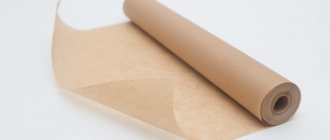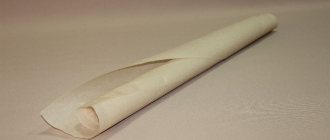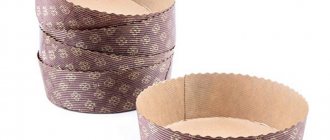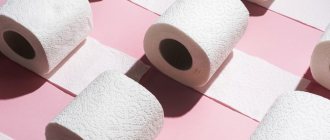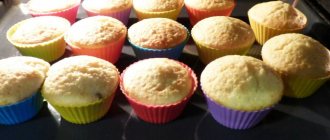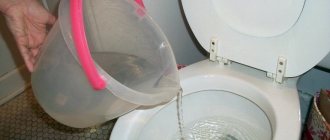3 types How to use: 7 rules Not only baking: 4 more ways to use What can be replaced
Once upon a time, our ancestors, in order to protect bread from soot, wrapped it in a fig leaf. The ancient Egyptians already used the equivalent of parchment. And our grandmothers and mothers used tracing paper. Today there is a special parchment paper that does not allow baked goods, fish or meat to burn, and leaves the baking sheet or baking dish clean.
How to replace parchment paper for baking?
How to replace parchment paper when baking:
- drawing tracing paper coated on both sides with vegetable oil;
- ordinary office paper (clean), also oiled;
- food parchment (thick paper from which baking bags in supermarkets are made).
Interesting materials:
Is it possible to convert mp4 to AVI? Is it possible to feed a cat dry food and meat? Is it possible to feed birds cookies? Is it possible to feed a puppy milk? Is it possible to feed a dog dry food and Natural food? Can acoustic foam be painted? Is it possible to paint a gas cylinder? Can you dye your hair again? Is it possible to dye your hair dark after bleaching it? Is it possible to swim in the Kuban Reservoir?
What does it look like
The areas of application of parchment are very wide, for example, in the furniture, clothing, fast food, household, and medicine industries. In appearance, this material is thin and transparent, depending on the scope of application it is divided into the following types:
| Parchment brand name | Where is it used? | Additional characteristic |
| "A B C". | Food packaging. | Fatty foods. |
| "D". | Production of multilayer packaging. When filtering, laminating. | Withstands temperatures of 230 °C. |
| "M". | For packaging of medications. | You can pack dressings. |
| “N”, “NZh”, “N-bio”. | Food storage up to 30 days. | Packaging material for long-term storage of products. |
| "VP". | For packaging low-fat products. | Printed images can be easily applied to paper; it can be laminated, metallized, or laminated. |
| "VP-M." | Packaging of household chemicals. | Can be used for packaging cosmetics. |
Aluminium foil
Foil is made from thin aluminum, which is an active metal. It comes in different lengths, widths and densities. Very thin foil can tear when wrapping food in it; very dense foil does not bend well, so it is inconvenient to wrap meat or fish with it. It is better to choose medium density foil.
The advantage of foil is that the aluminum sheet can withstand temperatures up to 600°C, so you can bake delicious meat or potatoes in it. And not only in the oven, but also on coals in an outdoor barbecue. During baking, the high temperature is evenly maintained in the foil, and the aluminum does not allow the juice to evaporate, which makes the products very juicy.
- Avoid acids and alkalis. For example, do not pour lemon juice, wine, or vinegar marinades on foil-wrapped foods. Also, do not cover dough that contains baking powder with it. Because aluminum, when combined with air, is covered with a protective film of oxide, which prevents it from oxidizing. And acid and alkali dissolve this film, which releases harmful aluminum salts.
- Lubricate meat or fish with sunflower oil before placing it in foil, otherwise they will stick.
- Wrap food in foil the right way around. The leaf has a shiny and matte side. Shiny well reflects the heat that the oven gives off when heating and food does not stick to it. Therefore, spread the foil with the matte side facing the table and the shiny side facing the food. Wrap the food in an envelope or cover it with another layer of foil with the shiny side facing inward.
- Foil should never be used for baking food in the microwave. When aluminum comes into contact with the walls of the microwave oven, sparks will appear, which will damage the device.
- Food in foil will cook faster than on an open baking sheet.
- You can store food in the refrigerator in foil.
Baking in the oven
The introduction of parchment quickly became widespread due to its multifunctional use. With its help, you can not only prepare homemade pastries, you can also simply bake poultry, fish, and meat with it. Some housewives place a sheet of parchment on the frying pan while frying the cutlets. This reduces vegetable oil consumption and makes washing dishes easier.
Before using baking parchment in the oven, you need to adjust it to the size of the baking dish. If necessary, it can be oiled with any cooking oil. It is important to remember that you need to lay the parchment with the glossy side up.
join the discussion
Share with your friends
Every housewife must have baking paper in her arsenal. It is simply necessary for preparing hot dishes from dough, baked meat and confectionery.
Bake and decorate
You can build a baking dish yourself. To do this, place the product intended for baking in the center of the sheet. Connect the opposite ends in pairs (twist them or tie them for security). Or you can simply pack the product, for example, fish, in an envelope. To prepare, transfer the assembled structure to a baking sheet or wire rack and place in the oven.
Making a baking envelope out of paper
Roll up small balls of paper and pour in the biscuit dough (not to the brim). Cover a heatproof dish with foil, poke holes in the foil at some distance from each other, secure the edges and insert balls of dough into the holes. Bake in the oven as usual.
Bake small batches of baked goods
The bag can be easily turned into a pastry bag. To do this, for example, pour melted chocolate into it, cut off the tip and decorate the cake.
Decorating baked goods
In the center of the sheet, cut out a beautiful pattern, a heart or a snowflake - you will get a stencil. Place on a cake, cupcake or pie and sprinkle powdered sugar on top - beautiful!
Use as a stencil
Care of chrome surfaces
Shiny faucets in the bathroom and kitchen look very beautiful and stylish. The thin chrome coating, which is applied electrolytically, not only gives the faucets an attractive appearance, but also protects their surface.
Thus, it is important to keep this top layer clean. This will ensure long service life for faucets, as well as any other products with a similar coating. Waxed parchment paper will help maintain the original shine and shine.
By the way, baking paper also helps remove traces of grease stains from stainless steel items. Housewives who have stainless steel pots among their kitchen utensils should take note of this information.
Material advantages
Baking paper is an environmentally friendly natural material. Its capabilities are not limited to use only in baking - it is suitable for freezing food and preparing cold confectionery dishes (here the material performs the function of preserving the shape of the product).
In baking, parchment is used repeatedly (at least 5 times), and this is an undoubted economic benefit. Baking paper is available in several types - they differ in the raw materials used in production and quality.
To lubricate or not
Despite the popularity of baking paper in modern cooking, not everyone knows whether it needs to be greased with vegetable oil before putting it in the oven. The answer to this question can be found on the packaging of the parchment. Some manufacturers treat sheets of paper with silicone, indicating this fact in the product characteristics. In this case, no additional manipulations are required. The baked goods are placed on parchment and sent to the oven.
If there is no impregnation marking on the package, the sheet can be coated with butter or vegetable oil. However, if you are planning to bake shortcrust pastry, you should not do this. The fat released from the product as the temperature rises will ensure the processing of the parchment.
What is it for?
Main applications:
- Paper for baking in the oven can be represented by different materials, for example, thin tracing paper. It is considered fragile; it not only sticks to the biscuit, but also quickly becomes saturated with moisture. If a dish is cooked in the oven for several hours, the tracing paper may crumble or become brittle. Before using this paper in cooking, it is pre-greased.
- Smooth, all-purpose baking parchment has a thin silicone coating so it won't stick to your food. Such sheets do not need to be lubricated; they do not allow moisture and grease to pass through. They can be used repeatedly and can withstand high temperatures.
- Durable, thick brown baking paper is used for baking dishes made from any type of dough. It absorbs fat well, but if the baked goods are low-fat, then the parchment is pre-greased with oil.
- Silicone parchment paper has a double coating, which is why the price is higher than its cheap counterparts. The expensive material has a three-dimensional baking structure, plus a special air layer. It appears brown in color, but is sold in the form of sheets.
Homemade pie
Many people are often faced with the question of how to use parchment to bake a cake. The principle of operation of popular paper is the same as for any other confectionery products. Usually, instructions for use can be found directly on the parchment packaging.
The emergence of various household appliances has made it easier for many housewives to work in the kitchen. The multicooker has become a truly indispensable device. With its help it is very easy to prepare a wide variety of dishes, and some even bake homemade pies in it. Even then, you can use parchment paper. This will prevent the baked goods from burning, and it will be much easier to clean the pan later.
Master class on making a product using the parchment technique
The master class on making postcards that we offer will allow you to understand the principle of the master’s work using the parchment craft technique. So, what steps need to be taken in parchment:
- Prepare tools and template.
- Using masking tape, adhere the parchment to the drawing. Please note that the transfer will go to the wrong side of the tracing paper, so it should be attached correctly from the beginning.
- Place the tracing paper with the design on the embossing mat (or mouse pad, if you don’t have a special one).
- Using a pen whose core does not write, transfer the drawing onto tracing paper. You need to press with such force that a white mark remains on the parchment, but there are no breaks.
- Place the tracing paper face down on the embossing mat. Use ballpoint tools to trace the design.
- Use a larger diameter ball to whiten the pattern, adjusting the degree of pressure. As you work, you should turn the tracing paper over and check how the drawing looks from the front side. The entire drawing must be drawn and whitened.
- After complete tracing, begin perforating. Place parchment with the design outlined on the front side on the perforation mat. Take the needles and start piercing the pattern. Insert the needles vertically into the tracing paper so that the holes are the same size.
- Using thin and sharp scissors, cut out the pierced section of the design to create the illusion of lace. Remove the cut out tracing paper.
- To color the work, you need to lay the parchment face down on the mat and use colored pencils to color the desired areas. If the colors are not bright enough, you can additionally paint the design on the front side.
- Select cardboard according to the tone and cut out a blank for the postcard. Fold the workpiece in half.
- Cut out the required strips of double-sided tape and attach it to the wrong side of the parchment.
- Glue the parchment paper to the cardboard base. Additionally, using a thin brush or toothpick, apply transparent glue to those places that will not be noticeable when gluing.
- Press and wait for the glue and paper to interact.
- Wait for the glue to dry completely.
Using the parchment craft technique, you can decorate many products: vases, flower pots, albums, books, bookmarks, and make decorations for clothes, bags and furniture.
Delicate and subtle, the parchment technique requires perseverance, accuracy and attention from the master.
What is parchment
Baking paper used to be a common item in grocery stores. They wrapped food in it, not knowing what valuable qualities it possessed. To make parchment, huge sheets of cellulose (porous paper) are used. During the production process, they are treated with solutions of special acids, resulting in hydrolysis.
The resulting parchment is washed in several waters, followed by drying. The finished paper is cut into smaller sheets, rolled and packaged. In this form, parchment paper goes on sale. Thanks to special processing, it is able to withstand high temperatures, in addition, it does not limp when wet.
Peculiarities
Baking parchment is needed to maintain the shape of the baked dish by reducing the sticking of the product to the baking sheet. Moreover, this option is relevant not only when creating hot baked goods, but also for cold sweet products, for example, cheesecakes and tiramisu. The use of baking paper significantly reduces labor costs for washing dishes and embossed shapes, so it can be purchased in stores not only in the form of flat leaves, but also as a mold for cupcakes and muffins.
Baking paper is truly indispensable when packaging prepared food, as well as medicines and any sterile items. This will prevent spoilage, contamination and drying out of food. Baking paper has long been adopted by catering enterprises, in particular, take-out restaurants.
Thanks to its exceptional water and grease resistance, baking paper allows you to keep your prepared dish hot for as long as possible. By rolling the dough between several layers of paper, you can get ultra-thin cakes. They are transferred to the oven directly on a piece of paper, thereby eliminating the risk of breaking them along the way.
Baking paper can be used to make very good food corners for cream, condensed milk, as well as melted chocolate - by rolling them up like a bag, you can quickly and easily decorate homemade baked goods with decorative roses, curls, or make an interesting inscription.
Paper is often used to make stencils for confectionery decorations - to do this, you just need to place the sheet on the pattern you like, trace it with a pencil and cut it out, then transfer the template to a cake or pie and sprinkle with grated chocolate, cocoa or sweet powder. Some housewives use multi-colored coconut flakes.
If you don’t have microwave-safe dishes, you can heat the dish directly on baking paper - in this case, all its taste properties are fully preserved.
Food grade unbleached parchment
This is a higher quality thin paper that is popular for storing food and preparing pies and other hot dishes. The basis for its production is high-fat cellulose, therefore the products are characterized by exceptional environmental friendliness and safety for humans. However, it should be borne in mind that unbleached parchment retains only fat and allows moisture to pass through - this significantly limits the scope of its use.
In addition, the recommended heating temperature when using this material should not exceed 170 degrees.
Food grade parchment
This is classic baking paper - quite durable and smooth to the touch. As a rule, it is made in brown color. The basis for parchment is a porous filter base, treated with 50% sulfuric acid and forced dried. This production method gives the paper increased water and grease resistance, and these properties remain unchanged when heated to 230 degrees.
This material is biologically inert, it allows air to pass through, thanks to which the product is able to “breathe” without absorbing any extra odors. The strength coefficient of traditional food parchment is twice as high as the corresponding parameter for conventional baking paper, which makes it possible to use the product for packaging products such as margarine, butter, spreads, sweet cheeses and dessert curd masses.
Siliconized parchment
This is one of the most popular types of baking paper these days. Such parchment easily lags behind finished products of all types, and does not require grease. The heat resistance coefficient significantly exceeds the parameters of all other types of baking paper and can withstand prolonged heating up to 300 degrees. It is important that such paper can be used many times.
Parchment with a siliconized coating allows you to transfer layers of puff pastry before freezing, as well as store sliced cheese and sausage - in this case, the product remains fresh longer than during normal storage.
Special silicone paper is considered a separate type of silicone-coated paper - it has a denser coating, which means it can be used more times.
Tips for choosing
The relevance of tracing paper, which our mothers and grandmothers often used instead of baking parchment, is not great these days - the scope of its use is significantly limited. Food-grade parchment paper is the most popular among housewives. It is good because it does not require additional use of oil and at the same time ideally retains the shape of the baked product.
Experienced confectioners prefer silicone-coated paper because it is easy to use, used for all types of baked goods, and can easily withstand temperatures up to 300 degrees for a long time.
Baking paper is sold in a wide variety in hardware stores and online stores. Several dozen enterprises are engaged in its production, but the most popular are the products of the Paclan and Nordic brands.
Paclan parchment is paper treated with silicone coating, thanks to which it perfectly follows the surface and contours of the baking sheet, does not crumble, does not stick to the dough and can be used repeatedly. Although this parchment is quite thin, it is still quite durable and can withstand the highest temperatures.
Butter buns
Fans of homemade baking often encounter such a nuisance as burning. In addition, products with filling often leave black fried marks on the baking sheet, which are quite difficult to wash off. If you know how to use parchment for baking buns, this problem can be easily avoided.
If you are planning to make buns at home, you should get some parchment paper. The sheet is spread on a dry and clean baking sheet, if necessary, the protruding edges are trimmed and greased with vegetable oil. The dough is placed on parchment and left to rise in a warm place.
If you need to quickly prepare baked goods and there is no way to buy special paper, it can be easily replaced.
- You can use tracing paper instead of parchment. It is often used when sewing or drawing. This paper is thinner but has similar quality to processed pulp. Having covered the baking sheet, it must be coated with oil or fat.
- Foil, also greased with oil, is often used as a substitute for parchment. However, you should carefully monitor the baking. Thin metallized paper can increase the temperature, thereby speeding up the cooking process.
- Recently, many housewives have been using silicone baking products. These are all kinds of rugs, molds for bread, cookies, and cakes. Using them in the kitchen, you can do without parchment.
- Use the tools at hand to effectively replace baking paper. Notebook, landscape, oiled sheets, baking sleeve, treated with fat. Even a foil wrapper for butter can successfully replace popular paper.
To avoid troubles, you should not use newspapers, cardboard, plastic bags, or plain paper for baking without pre-oiling.
